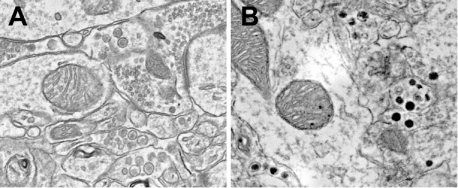
July 22, 2024
Salk scientists create methods to study messenger proteins in the brain called neuropeptides, finding they control the brain’s fear response in mice—a finding that may help develop more effective painkillers and treatments for fear-related conditions like PTSD and anxiety
Salk scientists create methods to study messenger proteins in the brain called neuropeptides, finding they control the brain’s fear response in mice—a finding that may help develop more effective painkillers and treatments for fear-related conditions like PTSD and anxiety
LA JOLLA—In the split second as you accidentally touch the hot handle of a cast iron skillet, pain and a sense of danger rush in. Sensory signals travel from the pain receptors in your finger, up through your spinal cord, and into your brainstem. Once there, a special group of neurons relays those pain signals to a higher brain area called the amygdala, where they trigger your emotional fear response and help you remember to avoid hot skillets in the future.

This process of translating pain into a threat memory occurs so quickly that scientists thought it must be mediated by fast-acting neurotransmitters. But when Salk researchers investigated the role of larger, slower-acting molecules called neuropeptides, they discovered these were the primary messengers in this fear circuit.
Neuropeptides are known to play an important role in brain communication, but the details have been unclear because scientists didn’t have the proper tools to study them in behaving animals. To determine the role of neuropeptides in this circuit, the Salk team created two new tools that finally allow scientists to observe and manipulate neuropeptide release in the brains of live mice.
The new study, published in Cell on July 22, 2024, revealed that the danger circuit relies on neuropeptides as its primary messengers, not fast neurotransmitters, and more than one neuropeptide is involved in the process. Their findings could lead to the development of more effective painkillers or new treatments for fear-related conditions like anxiety and PTSD (post-traumatic stress disorder).
“There is so much we have left to uncover about neuropeptides, but thankfully at Salk, we have the legacy of Nobel Prize winner Roger Guillemin’s work to highlight their importance and encourage our discovery,” says senior author Sung Han, associate professor and Pioneer Fund Development Chair at Salk. “To do this, we created two genetically encoded tools for monitoring and silencing neuropeptide release from nerve endings. We believe these new tools will significantly advance the field of neuropeptide research, and our discovery of their role in fear processing is really just the beginning.”
To process and react to things in our environment, information must travel throughout our body and brain. These signals are sent and received by neurons, which form organized circuits that guide information where it needs to go. Neurons communicate with each other by sending and receiving molecules like neurotransmitters and neuropeptides.

Neuropeptides are generally accepted as neuromodulators that help and modulate the action of main neurotransmitters. However, early pioneers like Roger Guillemin proposed that neuropeptides can act as main transmitters themselves. This concept has not been rigorously tested due to the lack of tools for visualizing and manipulating their release in behaving animals. The Salk team set out to explore neuropeptides with the goal of developing new tools to better understand their role in brain circuits.
To specifically target neuropeptides, Han’s team took advantage of one of their unique characteristics—while typical neurotransmitters are packaged in small spheres called synaptic vesicles, neuropeptides are packaged in large dense core vesicles. By engineering biochemical tools to target these large vesicles, they created neuropeptide sensor and silencer tools. The sensor tags large dense core vesicles with proteins that glow when they are released from the nerve ending, allowing the researchers to watch neuropeptide release in live time. The silencer specifically degrades neuropeptides within large dense core vesicles, revealing what happens in the brain when neuropeptides are absent.
"We have created a novel way to trace neuropeptide travel and function in the brains of living animals,” says Dong-Il Kim, first author of the study and postdoctoral researcher in Han’s lab. “These tools will help further our understanding of the brain’s neuropeptide circuits and enable neuroscientists to explore questions that were previously difficult to address.”
Using their newly developed neuropeptide sensor and silencer, together with existing sensor and silencer tools for glutamate (the brain’s most abundant neurotransmitter), the researchers looked at how neuropeptides and glutamate behaved in live mice as they experienced a mild stimulus—just enough to stimulate the fear circuit. They found that neuropeptides, but not glutamate, were released during the stimulus. What’s more, silencing neuropeptide release reduced fear behaviors in the mice, but silencing glutamate had no effect.
To Han’s surprise and delight, this brainstem fear circuit relied on neuropeptides as its primary messenger molecules rather than glutamate. Furthermore, their findings support their ongoing investigation into PACAP—a neuropeptide that modulates panic disorder.
“These new tools and discoveries are an important step toward better neurological drug development,” says Han. “We found that multiple neuropeptides are packaged together in a single vesicle and released all at once by a painful stimulus to function in this fear circuit, which made us think, ‘This might be why some drugs that target only one neuropeptide are failing in clinical trials.’ With this new information, we can provide insights to develop new drugs that target multiple neuropeptide receptors at once, which may serve as better painkillers or help treat fear-related disorders like PTSD.”
Equipped with their new neuropeptide toolbox, the team will soon begin to explore other brain circuits and processes. Future insights into neuropeptide signaling in other areas of the brain, as well as the newfound understanding that targeting multiple neuropeptides at once is necessary, should inspire the development of more effective drugs to treat diverse neurological disorders.
Other authors include Seahyung Park, Mao Ye, Sukjae Kang, Jinho Jhang, Joan Vaughan, and Alan Saghatelian of Salk; Sekun Park, Jane Chen, Avery Hunker, Larry Zweifel, and Richard Palmiter of University of Washington; and Kathleen Caron of University of North Carolina at Chapel Hill.
The work was supported by the National Institutes of Health (NIMH 5R01MH116203, NINDS 1RF1NS128680) and a Salk Institute Innovation Grant.
DOI: 10.1016/j.cell.2024.06.035
JOURNAL
Cell
AUTHORS
Dong-Il Kim, Sekun Park, Seahyung Park, Mao Ye, Jane Y. Chen, Sukjae J. Kang, Jinho Jhang, Avery C. Hunker, Larry S. Zweifel, Kathleen M. Caron, Joan M. Vaughan, Alan Saghatelian, Richard D. Palmiter, Sung Han
Office of Communications
Tel: (858) 453-4100
press@salk.edu
Unlocking the secrets of life itself is the driving force behind the Salk Institute. Our team of world-class, award-winning scientists pushes the boundaries of knowledge in areas such as neuroscience, cancer research, aging, immunobiology, plant biology, computational biology and more. Founded by Jonas Salk, developer of the first safe and effective polio vaccine, the Institute is an independent, nonprofit research organization and architectural landmark: small by choice, intimate by nature, and fearless in the face of any challenge.